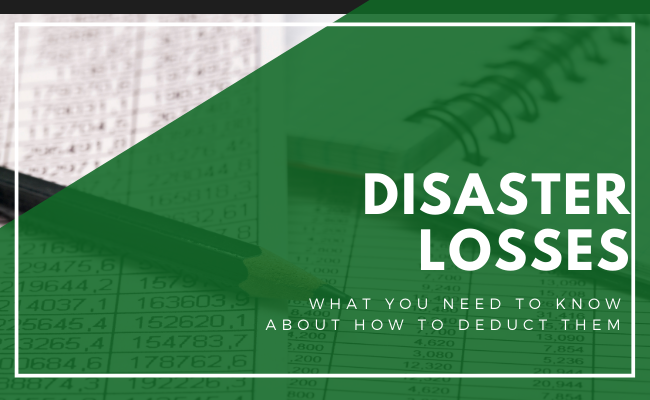Deducting Disaster Losses for Individuals
We seem to be living in an age of natural disasters.
Uninsured losses to personal non-business property such as your home, personal belongings, or personal car due to a disaster can be deductible.
Unfortunately, the rules have become more complex and not as generous as they used to be. (Of course, because who needs easy after a natural disaster)
What is Causality?
The principle of or relationship between cause and effect. So basically, Karma. However, not in the true sense of the word. It’s more like the way we toss their word around when something goes wrong to someone we know.
(At least, that’s the way I use it. )
Only Causality Losses Are Deductible
Damage to personal property caused by a disaster is deductible only if it qualifies as a causality loss. A causality loss is:
- Permanent damage,
- Destruction, or
- Loss of property due to:
- A recognizable event that is sudden, unexpected, or unusual.
Deductible causality losses include but are not limited to

- earthquakes
- fires
- floods
- car accidents caused by disasters (not by driver negligence)
- government-ordered demolition
- relocation of a building that is unsafe to use because of a disaster
- landslides
- oil spills
- sonic booms
- storms, including hurricanes and tornadoes
- terrorist attacks
- theft
- vandalism
- volcanic eruptions
Losses due to slow, progressive deterioration of property are not deductible as a causality loss.
So, deterioration of a home’s roof due to normal wind and weather conditions is not a deductible causality loss. However, we here in Florida know hurricanes best. If your roof is damaged due to a hurricane, that is considered a causality loss.
For the loss to be deductible, there must be physical damage to property, not merely a decrease in value. Nor is lost revenue a deductible personal causality loss.
Thus, the COVD-19 pandemic is not a causality loss, because it did not cause physical damage to property. (Only to human beings).
Deductible Causality Losses Come from Federally Declared Disasters
In the past, all types of causality losses were deductible. Although, the Tax Cuts and Jobs Act radically changed the rules for 2018 through 2025. During these years, causality losses to personal property such as your home, personal belongings, or car are deductible only if caused by a federally declared disaster. This is a huge change, say your house burns down because of a massive forest fire (declare a federal disaster), you can take a causality loss deduction for your uninsured losses. Unlike your house burning down due to faulty wiring. You get no causality loss deduction.
All other causality losses to personal non-business property are not directly deductible during these years—you may deduct them only from causality gains, if any, as described below.
There are two types of disaster declarations that the U.S. president can make under the Robert T. Stafford Disaster Relief and Emergency Assistance Act: Emergency declarations and major disaster declarations.
- Both can qualify for the causality loss deduction.
- Both apply statewide.
- The Federal Emergency Management Agency (FEMA) maintains a list of declared disasters on its website.
Check out the FEMA link for more information: FEMA
Because of these restrictions, it is in your best interest to have adequate insurance coverage for your valuable personally owned property—particularly your home. Don’t count on the tax code for any tax deduction if your home or other personal property is damaged or destroyed.
Only Uninsured Disaster Losses Are Deductible
Many, but far from all, causality losses are covered by insurance. You may deduct causality losses only to the extent they are not reimbursed by insurance or otherwise.
If a loss is insured, you must file a timely claim, even if it will result in the cancellation of your policy or an increase in premiums.
If you don’t file a claim, you get no causality deduction for the amount of your insurance coverage, but you can deduct the amount of your deductible.
You can’t claim your causality loss until you know with reasonable certainty whether or not you’ll receive insurance or other reimbursements. Technically, the loss isn’t “sustained” until this time. This could be the year following the causality event, or even later.
You must reduce the amount of your claimed causality loss by any insurance recovery you receive or reasonably expect to receive, even if it hasn’t yet been paid.
- If it later turns out that you receive less insurance than you expected, you can deduct the amount the following year.
- If you receive more insurance than expected and therefore claimed too large a causality loss, you include the extra amount as income in the year you receive it.
How to Calculate Causality Losses
 You calculate the deductible amount of a causality loss by
You calculate the deductible amount of a causality loss by
-
-
- Figuring the adjusted basis in the property before the disaster,
-
- Calculating the decrease in the property’s fair market value (FMV) after the disaster,
- Subtracting any insurance or other reimbursement received from the smaller of (1) and (2).
The adjusted basis= the property’s original cost + the cost of permanent improvements.
You can use IRS Publication 584, Causality, Disaster, and Theft Loss Workbook (Personal-Use Property) to figure your losses.
General Rule Limiting Personal Causality Loss Deductions
The general rule for deducting personal causality losses is that you may take the deduction only if you itemize your personal deductions on IRS Schedule A. In order for you to itemize, your deductible causality loss and other personal deductions (such as mortgage interest, real estate taxes, and medical expenses) must exceed the standard deduction.
In addition, you may deduct only the amount of the loss that exceeds 10 percent of your adjusted gross income (AGI) for the year.18 The 10-percent-of-AGI rule greatly limits or eliminates many causality loss deductions. The higher your income, the less you can deduct.
To add insult to injury, you must also subtract $100 from each causality or theft you suffered during the year. This reduction applies to each total causality loss. the number of pieces involved doesn’t matter. Only a single $100 reduction applies.
Special Causality Loss Limitation Rules for Qualified Disasters
Fortunately, many causality losses are not subject to the general limitation rules described above. For certain federally declared disasters and certain time periods
- 10% of AGI threshold is eliminated
- $100 floor is increased to $500
- Taxpayers may claim the deduction without itemizing and may increase their standard deduction by the amount of their net disaster losses.
Obviously, these special rules can greatly increase your causality loss deduction. But these rules apply only to losses due to “qualified disasters.”
These are:
- Disaster losses sustained from January 1, 2020, to February 25, 2021, due to a federally declared major disaster (not including the COVID-19 pandemic);
- The disaster must have occurred between December 18, 2019, and December 27, 2020.
- Disaster losses sustained from January 1, 2018, through February 18, 2020, due to a federally declared major disaster;
- The disaster must have begun from January 1, 2018, through December 20, 2019, and ended by January 19, 2020.
- Disaster losses sustained in 2017 from Hurricanes Harvey, Irma, or Maria, or in the California wildfires in 2017 and January 2018.
When to Claim Causality Losses
You claim a causality loss by filing IRS Form 4684, Casualties and Thefts, with your return. You may always claim a causality loss the year it is sustained—this is usually the year it occurs, but can be later if you’re waiting on an insurance claim.
Also, there is the option of claiming it for the previous year, when a loss is caused by a federally declared disaster . This can provide a quick tax refund since you’ll get back part (or even all) of the tax you paid for the prior year.
Also, if your loss is subject to the 10-percent-of-AGI limitation, you’ll have a larger deduction if your AGI for the prior year is lower than for the year of the causality.
You must make an election to claim the loss for the preceding year on Form 4684. Make the election with your original or amended return for the earlier year. You have until October 15 to decide whether to file the election for the prior year.
Net Operating Loss
Now here’s a pleasant surprise. You treat the net amount of your personal causality loss as if it happened as a trade or business. That means, it can create a net operating loss (NOL) for the year. You carry back an NOL for 2018, 2019, or 2020 five years and obtain a refund of tax paid for those years. You then carry forward any unused amount indefinitely.

If you don’t want to carry back
the loss, you must elect to relinquish the entire carryback period and carry forward only.
If this seems difficult to follow (enter shameless plug) a great bookkeeper can assist you.
We will not only help you understanding this, but how to correctly file your taxes.
Causality Gains
It may seem counterintuitive, but it’s not uncommon to have a taxable gain instead of a loss from a causality. This occurs when the insurance proceeds you receive exceed the adjusted basis in the property.
However, you don’t have to include income insurance proceeds for property in your home. This is property not on a schedule or rider to your basic homeowner’s insurance policy.
A causality gain is taxable income. However, you can deduct all your causality losses for the year from your gains. This includes causality losses that are not due to federally declared disasters. You first deduct losses not from federal disasters and then deduct losses from federal disasters.
Avoiding the Disaster Gain
You can treat the causality as an involuntary conversion and postpone reporting the gain if you spend the reimbursement to repair or replace the property within two years. This time period is extended to four years for your main home if it was in a federally declared disaster area.
You can treat a total loss of your main home as if it is profit from the sale of your home, if you had a gain. If you qualify for the home sale exclusion, you can exclude from income $250,000 of your gain if single or $500,000 if married filing jointly. The destruction does not have to be from a federally declared disaster.
If the destruction exceeds the $250,000/$500,000 limitation, the excess gain may be deferred under the involuntary conversion rules.
The Importance of Documentation
Make sure you can document your causality losses. You’ll need to have
- Documents showing ownership of each asset, you are claiming as damaged or destroyed (for example, a deed or receipt);
- Contracts or purchase receipts showing the original cost of the item, plus any improvements you made to it;
- Evidence of the property’s FMV, such as insurance records, an appraisal, or receipts or estimates for the cost of repair.
Now, keeping in mind that your house may have just been destroyed. It may be a good idea to keep these records in a safe place, as well as, digital copies stored on your computer or cloud account.
For this and more helpful article please search our library of topics. Blog






